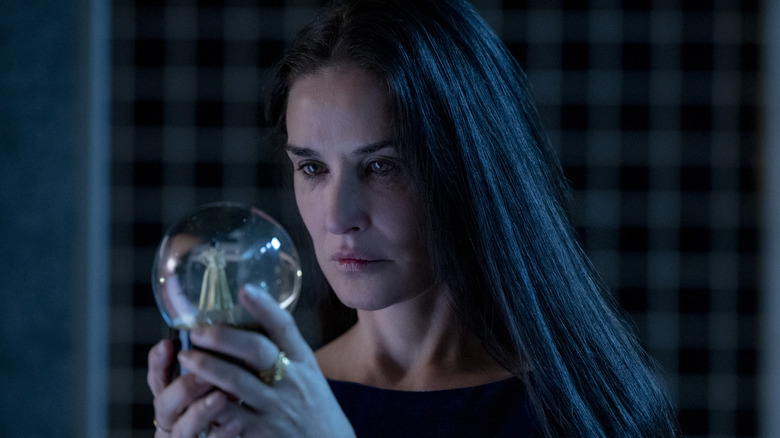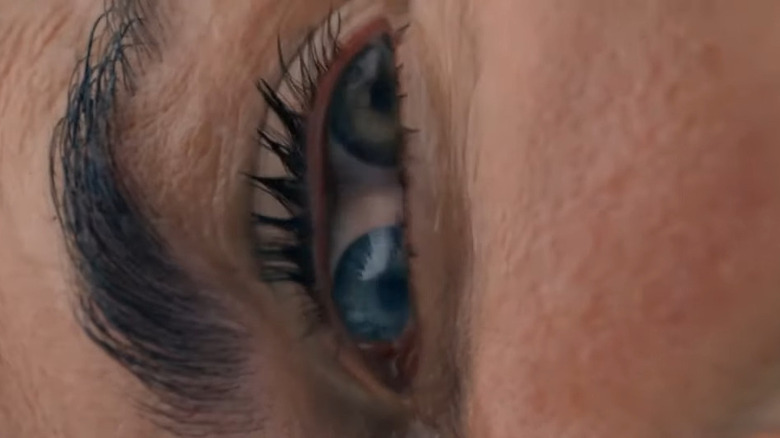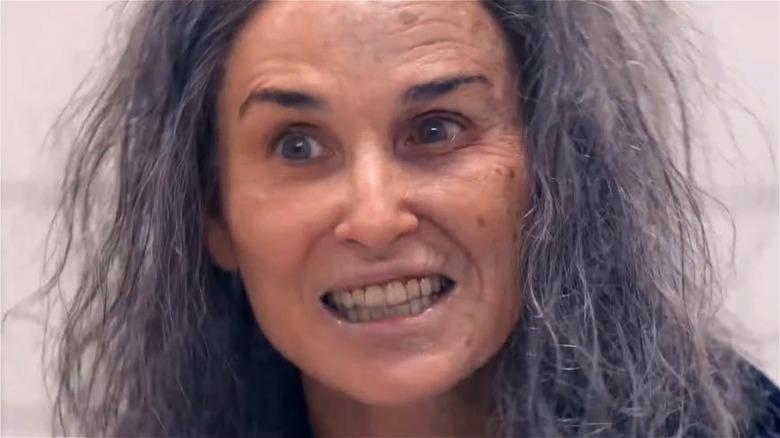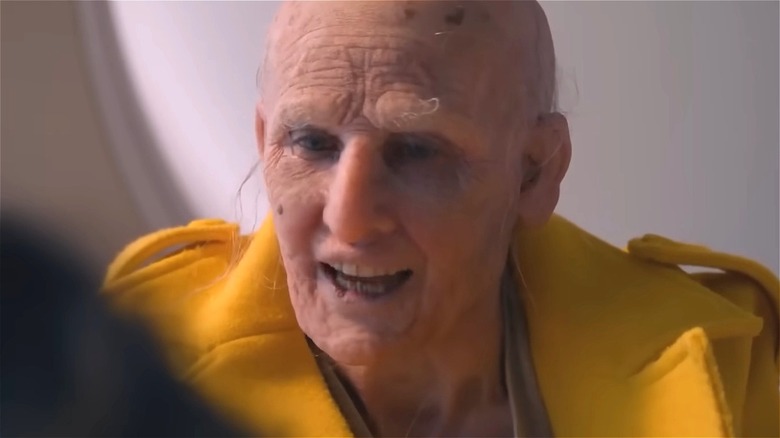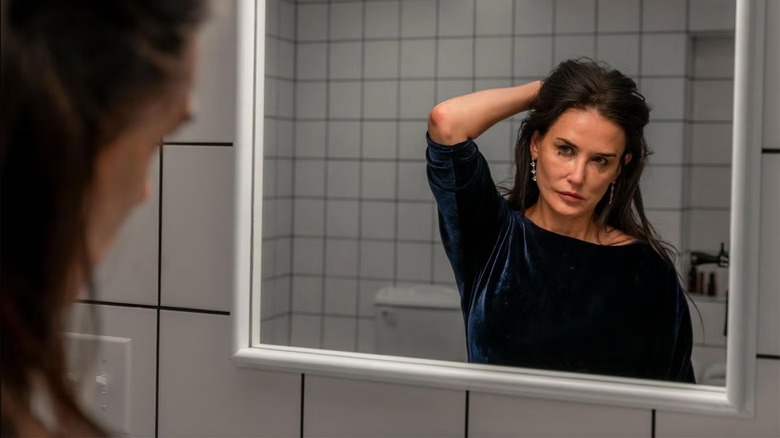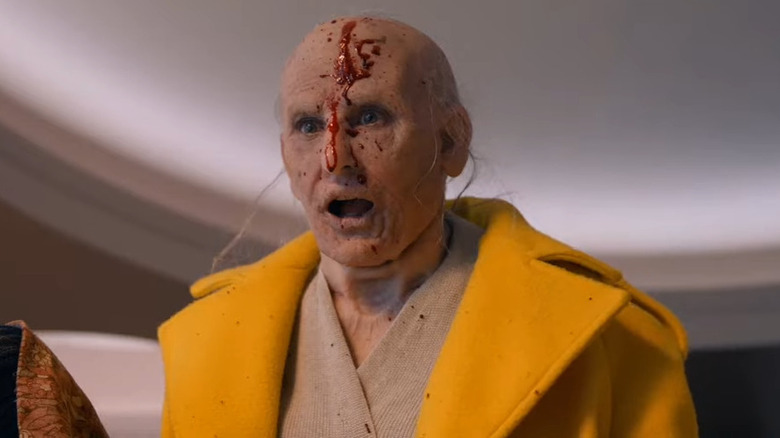How Demi Moore Transformed Into A Monster In The Substance
When it comes to actors who are willing to sacrifice themselves for the good of their latest project, Demi Moore has long been one of the most able stars in Hollywood. Whether it's shaving her head and going through Navy SEAL training for "G.I. Jane" or dedicating herself to learning pole dancing routines for "Striptease" (the movie that almost ended Moore's career), she has shown an admirable dedication to her craft. She's never hesitated to do what she must to get into character, and 2024's "The Substance" contains her most extreme transformation ever.
Diving deep into the horrors generated by self-loathing, policed beauty standards, and other modern ills, writer-director Coralie Fargeat's film sees Moore fight back against ageism. A potent rejection of sexism and infighting between older and younger women, "The Substance" provides Moore with a new kind of role — one that helps her, in turn, rebel against the tabloid press that mocked her for seeing her own worth and daring to be fearless regarding her choice of material.
What sort of transformation did Moore have to go through to play the lead role of fading star Elisabeth Sparkle? How much time did she spend in the makeup chair every day to get the look just right? And would she do it all again for another part? Keep reading to learn all of this and more.
Contains spoilers for "The Substance."
What is The Substance and who does Demi Moore play in it?
"The Substance" is a body horror movie that's centered around Elisabeth Sparkle (Demi Moore), a fitness guru and actor who ruled the world during the 1980s and 1990s. But as Sparkle enters her fifties, she's fired by her afternoon exercise show's top brass (Dennis Quaid). They want to replace her with a younger model. Livid, she injures herself in a car crash when she sees the billboard promoting the show being taken down. In the hospital, she is covertly slipped information about the titular Substance while she recovers — it's a black market, designer drug that supposedly transforms you into your youngest, best self. But Elisabeth is shocked when, instead of improving the body she already has, the drug causes her to spawn a whole second person, who emerges from her back.
This new adult being is named Sue (Margaret Qualley) and she takes over Elisabeth's show, developing a party-heavy lifestyle while Elisabeth sinks into a depression. Elisabeth begins to slowly rot as Sue avoids coming home to attend to her commitments and duties related to her partnership with Elisabeth. "Remember, you are one," warns the packaging related to the treatment, and indeed Sue and Elisabeth are symbiotically connected to one another as their collective consciousness must switch bodies every seven days. This ensures proper rest and is supposed to keep both bodies alive.
The inactive body must be fed intravenously every week. Sue also has to inject herself with activator fluid to keep herself from devolving due to her status as a clone. Unfortunately, Sue and Elisabeth soon see themselves as competitive individuals instead of a single entity, leading to violence. Sue eventually tries to save her deteriorating body by taking even more of the Substance, resulting in her mutation into the half-baked being Monstro Elisasue. The end result is explosive decomposition and death — but not before she soaks everyone around her in blood.
Becoming a monster was both scary and liberating for Demi Moore
Obliterating your conception of beauty and self to play a hideous movie monster is a tall order, but Demi Moore was up for the task, even if some parts of the journey proved difficult for her. Required to do full frontal nudity, plumb some very vulnerable places in her psyche, and spend hours in heavy makeup, Moore absolutely rose to the challenge. Being Elisabeth required total emotional starkness from the actor — but she ultimately found pride in her part.
"It was a very hard film, very raw; very vulnerable to make. But at the same time liberating," Moore told The Guardian. "I had less pressure than Margaret, because she had the added pressure to look amazing. I degrade throughout and I knew going in that I wasn't going to be shot in the most glamorous way, or with the edges softened. In fact, the opposite. But there was something freeing about that. What really struck me was the harsh violence against oneself. It's not what's being done to you, it's what we do to ourselves." Indeed, the treatment she had to give herself was harsh and very hard to watch for viewers.
In one scene, Elisabeth becomes so frustrated by the flaws she sees in herself while making herself up for a date that she rubs off her makeup in such a fierce and angry way that she actually scrubbed her own skin raw. "Emotionally, that idea that I think many of us have been where we're trying to make something better and then we just keep making it worse," she said on CBS Sunday Morning. "For me, it's one of the most heart-wrenching moments in the whole film." The scene took 15 takes to complete, and Moore was willing to keep going. "The makeup artist stepped in and said, 'We're done,'" she told Variety.
It took over nine hours to turn Demi Moore into a monster on some days
Putting together Elisabeth's disintegration for your average day of shooting took anywhere from six to nine and a half hours in the makeup chair for Demi Moore, the actor told Seth Myers. Her face alone bore 14 individual prosthetic pieces. Moore told Entertainment Weekly that she had to be mindful about knocking the prosthetics, as tugging off a chunk might result in facial damage. "You have to be as careful if not more careful taking it off so you don't destroy your skin," she said. The process of removing the prosthetics was a marathon in itself, taking an additional two hours.
Those working beside Moore noted that the prosthetics didn't stop at the actor's face. "She has the full leg prosthetic, full arm, full back prosthetic. Then the face and the wig. Plus, it has to go under water and everything needs to be waterproof," head special effects artist Pierre-Olivier Persin said of the various trials Moore went through during the shoot to The Daily Beast. He added to GQ Magazine that the entire upper half of her body was swathed in prosthetics to achieve the look.
The three stages of Moore's decomposition were given nicknames: "Requiem," a reference to Ellen Burstyn's look in the psychological drama "Requiem for a Dream;" the hunchbacked and melting "Gollum," for when Elisabeth goes bald and develops physical sagging, in reference to the fish-gobbling creature from "The Lord of the Rings;" and simply "Monstro" for the character's final form. While Moore plays the first two forms, Margaret Qualley plays Monstro Elisasue during her final decomposition. The end result is a twisted being that mocks beauty standards — we're talking teeth, lips, and breasts everywhere — while also drawing sympathy. Persin said that director Coralie Fargeat wanted the character to resemble the Elephant Man, looking both horrifying but easy to love at the same time.
Why the makeup team loved working with Demi Moore
One would think that being stuck in the makeup chair for so many hours would cause dissention or at least annoyance, but "The Substance" head makeup artist Pierre-Olivier Persin revealed that it was quite the opposite when it came to the film's star. "Demi was a real trooper, never complaining or even looking bored and getting distracted during the process," Pierre-Olivier Persin told GQ Magazine. He also praised Moore's patience during his interview with The Daily Beast, saying, "She was never complaining. She was with us all the way through looking in the mirror and looking at every detail, sitting still. [She was] the dream actor for us."
Persin added that he teamed up with Moore to help bring about Elisabeth Sparkle's degeneration. They worked with the movie's hair and makeup team to properly orchestrate Elisabeth's full look, which starts with a finger that goes purple and wilts and ends with the horror that becomes Monstro Elisasue. Every frizzled curl and wrinkle was agreed upon by the entire team. Together, they were able to create a look of completeness and cohesion that helps the audience believe that this two-woman story only involves two women and not further stunt people and stand-ins. Moore being so completely involved in the development of her unique character meant that the entire process of putting together Elisabeth's downfall — which could have been difficult otherwise — was very smooth, and the film benefitted from this greatly.
The shocking ending of The Substance was always supposed to be a cathartic moment
Elisabeth Sparkle's disintegration is an extremely public affair. It's also a cathartic moment, a violent smashing of beauty standards and gender roles. Onstage during a New Year's Eve party being broadcast worldwide, Monstro Elisasue reacts in defiance and horror of her audience's rejection of her. They violently attack her but she — in an explosion of blood and viscera — rejects that rejection. She leaves the studio by coating them all in blood and running away, her depleted, melting body heading out to bask one more time in her faded glory at her Hollywood Walk of Fame star.
"She represents a reckoning and the release of the physical body," Moore told Vulture of Monstro Elisasue and her untimely destruction. Moore added that only when Monstro can look at herself in the mirror and see both sides of herself blended into a single frame can she truly embrace joy and personal satisfaction. It's a rejection of the standards that have kept her bound in misery and depression, unable to enjoy herself or to maintain a level of happiness in her personal life. Now there's nothing at all that can stop her — even death. It's a dark, bloody moment, but it's also a beautiful one.
Also speaking to Vulture, writer and director Coralie Fargeat said that having a "liberating climax" was always the goal. "The audience, for me, represents society. I depicted Elisabeth's genuine dream, which is to be loved by those people for who she really is," Fargeat said. "Having this explosion of blood and guts was a way to externalize the violence that I feel all those gazes and this beauty pressure put on us. It was a way for me to splatter it in the face of the audience to say, 'Look at what you're creating. You are responsible for this explosion.'"
Why Demi Moore played the Gollum version of her character instead of a body double
Demi Moore might have been inclined to use a body double for several scenes in "The Substance," but the actor shared the part with a stunt double. Why? Because Coralie Fargeat and Pierre-Olivier Persin wanted the most organic-looking monster they could create, which required visual consistency. That meant that Moore had to don the suit — not that she had any complaints about doing so. Persin confirmed to GQ that Fargeat resisted suggestions of using a lot of VFX, so a lot of prosthetics and puppetry exist in the final movie.
One of the Gollum version of Elisabeth's most horrifying scenes involves Elisabeth alone in her shower, her bottom and breasts sagging, her hair drifting down the drain. That's an emotional moment that's hard to replicate with a body double. But since it's in this form that Elisabeth and Sue have a huge fight, a stunt person and double were employed for some moments.
Little details helped enhance Elisabeth's hard physical decline, including the motion of the moving parts in the suit that Moore wore. "I didn't want to just go for a rubber suit, so it was silicone. It was more than a suit. It was more than prosthetics. Most of it was glued onto the body so it moved well," Persin confirmed to The Daily Beast. "For instance, the bum was sagging a little bit. We had hollow spaces inside the breasts and the bum so when she was walking, it was jiggling the bum."
What does Demi Moore think about the message that The Substance sends?
Demi Moore has had a lot to say about what kind of message "The Substance" sends to viewers. "It's a powerful shared experience. It's dealing with aging and the male perspective of the idealized woman that women have bought into," Moore told Seth Meyers during an appearance on "Late Night with Seth Meyers." Elisabeth Sparkle's inability to reject those standards and see other women as her friends and not her competition leads to her tragic death.
Moore knows all about the ups and downs of being a woman in Hollywood, as she revealed in her autobiography (which Coralie Fargeat read before they worked together). She understands why Elisabeth would react with depression and jealousy after losing her whole career. She's a character who has spent so long being overly focused on her body that being told her physical image is subpar sends her over the edge. It's no wonder that she goes to such extreme lengths to retain her youth.
Moore also noted to Variety that the biggest tragedy of Elisabeth's life is that she loses everything she could be due to her desperate pursuit of her fading youth. "The film raises an important idea: When you chase after something you think is better, you risk losing what you have," Moore said. In the end, Elisabeth's mutation into Sue, then Sue's descent into Monstro Elisasue, is the ultimate rejection of the male gaze. It's clear that Moore has some sympathy for her imperfect character, and that really shines through in her performance.
Would Demi Moore go through another extreme transformation for a role?
Would Demi Moore go through such a wild physical transformation again for another movie role? She has some mixed thoughts on that. "I will say, it's a much easier thing to read on paper," she said on "Late Night with Seth Meyers" regarding her daily transformation for the role. "But I'm so glad I had the experience. I feel like I have tremendous respect for those who have really gone all-in, where the whole film is that way. I may be thinking twice before I jump in again."
Even if Moore never takes on a part quite like Elisabeth Sparkle again, she's arguably redefined her career thanks to this unique and hard-hitting role. Could this just be the start of her time in the horror spotlight? Might she become this generation's Joan Crawford, who ended her career with a string of horror films? While she seems somewhat reluctant to take on roles that require a whole lot of makeup chair time, she hasn't rejected the notion of doing horror again altogether. Time will tell, but one thing's for sure — "The Substance" has opened the door to a new subgenre of body horror.
"The vast majority of female body-based horror deals with various aspects of the reproductive system, and it has largely been made by men," The Guardian said in its review. "And this is part of what makes French director Coralie Fargeat's gut-churningly visceral second feature so refreshing: 'The Substance' not only offers a female perspective on women's bodies, but also argues that things only start to get properly messy once fertility is a dim memory."
Is "The Substance" one of Moore's greatest ever films? Check out our list of Demi Moore's top movies of all time, ranked from worst to best.
